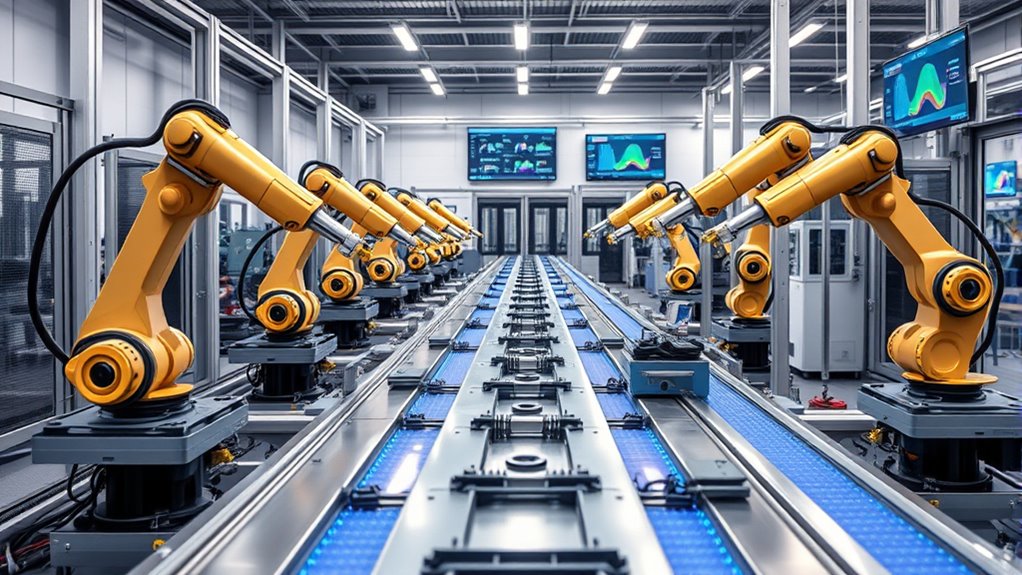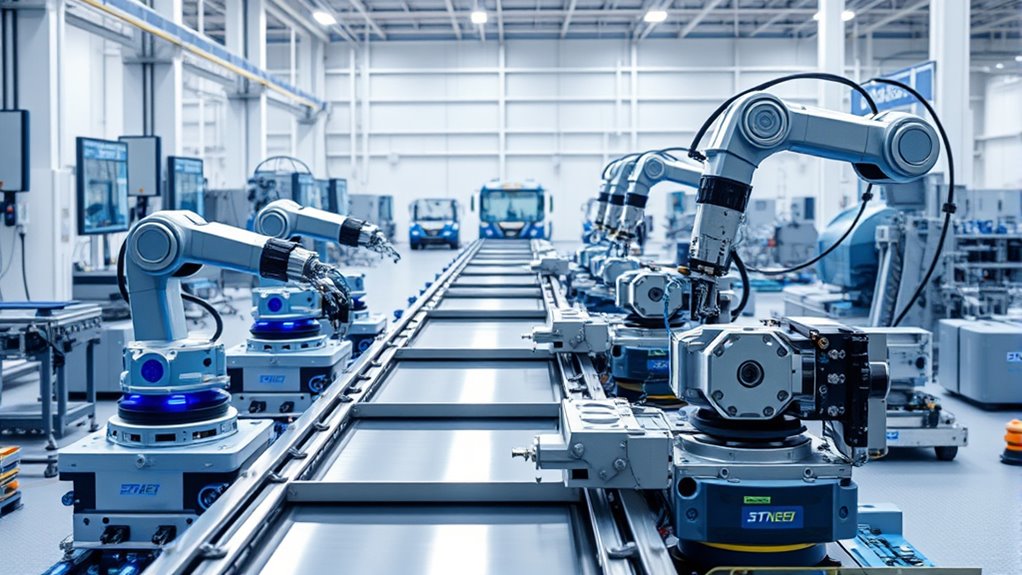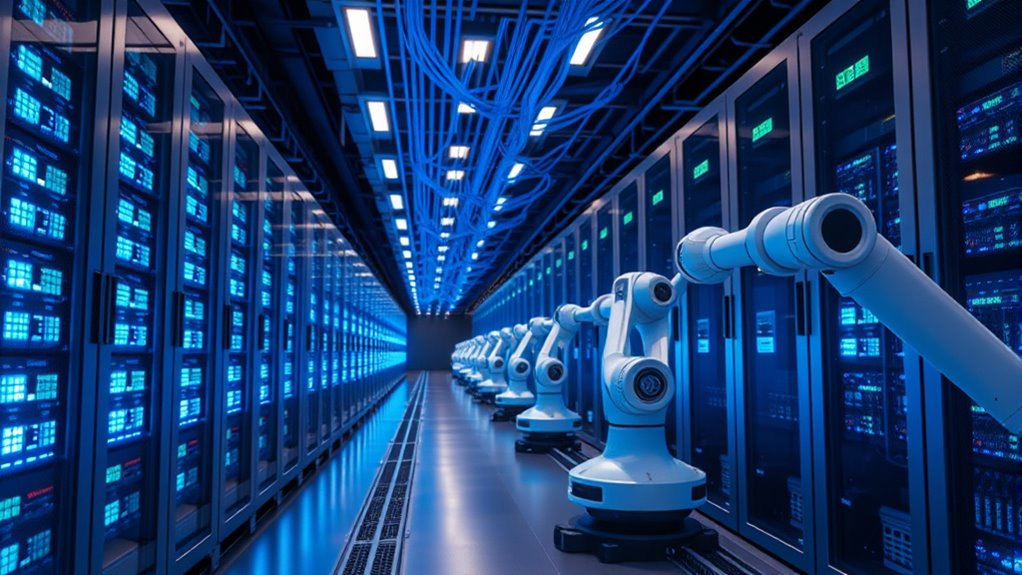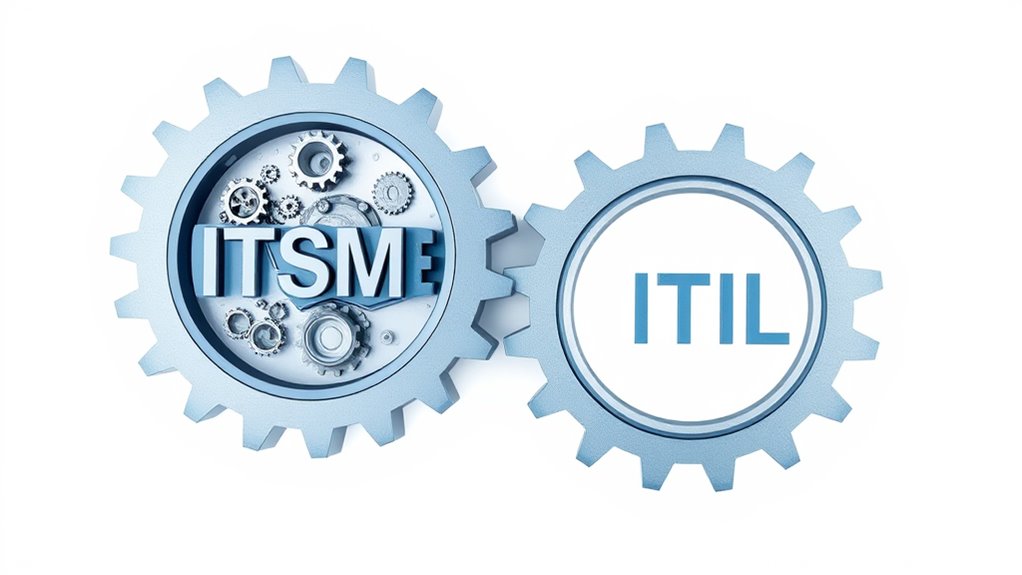Automation transforms industries through advanced technologies that minimize human intervention in operations and processes. Global adoption exceeds 60% of companies, driving a projected $226.8 billion market by 2025. While potentially displacing 92 million jobs by 2030, automation is expected to create 170 million new positions, resulting in a net gain of 78 million roles. Organizations implementing automated systems report 22% lower operating costs and 90% improved productivity. Understanding automation’s full impact reveals opportunities for growth and innovation.

Nearly every industry across the global economy is experiencing a profound transformation through automation, with over 60% of companies worldwide having already integrated automated systems into their operations by 2024. The global industrial automation and control systems market continues to expand rapidly, projected to reach $226.8 billion in 2025, with a compound annual growth rate of 10.8% through 2030. This growth is particularly pronounced in the Asia-Pacific region, which currently holds a 39% market share. Marketing departments have seen substantial progress in digital transformation, with 58% of marketing leaders now utilizing automated email campaigns.
Automation’s rapid expansion across industries signals a transformative era, with most global companies already embracing automated systems to stay competitive.
The impact of automation on productivity and cost efficiency has been remarkable, with over 90% of workers reporting improved productivity following automation implementation. Organizations typically experience a 22% reduction in operating costs, while robotic process automation delivers substantial returns on investment ranging from 30% to 200% within the first year. These gains stem from streamlined operations, enhanced quality control, and accelerated time-to-market capabilities. The hybrid industries sector demonstrates particularly strong performance with up to 9% growth, driven by pharmaceuticals, MedTech, and food & beverage segments. Business process outsourcing has shown that error reduction rates improve by up to 65% when implementing automation solutions.
The workforce landscape is undergoing significant changes due to automation, with projections indicating the displacement of 92 million jobs worldwide by 2030. However, this change is expected to generate 170 million new positions, resulting in a net gain of 78 million jobs globally. These changes emphasize a shift toward technology management and oversight roles, highlighting the critical importance of workforce preparation and reskilling initiatives.
Technological advances in robotics, artificial intelligence, machine learning, and the Internet of Things serve as primary catalysts for expanding industrial automation capabilities. As these technologies become more sophisticated and cost-effective, their deployment across diverse industries continues to grow. Integration with digital transformation strategies enables innovation and operational agility, while supporting mass customization and rapid prototyping to meet evolving consumer demands.
Despite the promising outlook, implementation challenges persist, with approximately 70% of digital transformation and automation projects falling short of their objectives. This underscores the importance of careful planning and execution in automation initiatives.
Nevertheless, factors such as skilled labor shortages and the need for enhanced operational efficiency continue to drive automation adoption across industries, particularly in manufacturing, logistics, and service sectors.
Frequently Asked Questions
How Much Does It Cost to Implement Automation Systems in a Business?
Automation implementation costs vary considerably based on system complexity and business size.
Small businesses using no-code platforms may spend several thousand dollars, while enterprise-wide solutions can reach millions.
Software licensing typically represents 30-50% of total investment, with integration costs and employee training adding 10-20%.
Most companies achieve ROI within 6-9 months, reporting average cost reductions of 22% through improved efficiency.
What Skills Do Employees Need to Work Alongside Automated Systems?
Employees working with automated systems need a combination of technical and soft skills.
Fundamental technical competencies include data analysis, process automation knowledge, and basic AI understanding.
Critical soft skills encompass analytical thinking, adaptability, and effective communication.
Digital collaboration abilities and cybersecurity awareness are also crucial.
Additionally, emotional intelligence helps navigate human-AI dynamics, while continuous learning guarantees workers stay current with evolving technologies.
Can Small Businesses Benefit From Automation, or Is It Only for Corporations?
Small businesses can greatly benefit from automation, as demonstrated by compelling data and outcomes.
Companies implementing automation typically save 240-360 hours annually on manual tasks while achieving 20-35% productivity improvements.
The technology delivers first-year ROI between 30-200% through reduced labor costs and fewer errors.
Automation also enables small businesses to scale operations efficiently without proportional staff increases, while improving customer service and employee satisfaction.
How Long Does It Typically Take to Transition From Manual to Automated Processes?
Shifting from manual to automated processes typically takes 6 to 12 months, depending on scope and complexity.
The journey begins with a one-month pilot testing phase, followed by optimization in month two. Full deployment extends over several months, requiring ongoing adjustments.
Factors affecting timeline include:
- Process complexity
- Organizational readiness
- Technology integration requirements
- Regulatory compliance needs
- Staff training requirements
What Are the Cybersecurity Risks Associated With Implementing Automated Systems?
Implementing automated systems introduces several critical cybersecurity risks. These include system vulnerabilities from automated detection limitations, insider threats from both malicious and negligent actors, and expanded attack surfaces through cloud integration.
AI-powered cyberattacks pose increasing challenges, with 74% of IT professionals reporting significant impacts. Additional concerns include unauthorized access through compromised credentials, zero-day exploits, and difficulties in maintaining effective incident response capabilities across complex automated infrastructures.









